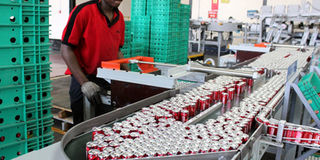Local content is an idea whose time has come

Battery manufacturing in process at the Eveready East Africa Ltd plant in Nakuru. PHOTO | FILE | NMG
What you need to know:
- The project insists on a minimum of 15 per cent or more components to be manufactured in Kenya by Local Content Providers to complete the investors’ products.
- The proposal presents the percentages and progression period before local content attains the 100 per cent threshold.
- The LCMP project is based on the belief that without local content regulations, there will be no meaningful manufacturing base built in the country.
It is important that as Kenya engages the United States to agree on a free trade policy that will see, inter alia, America’s goods get privileged entry into the Kenyan market, I revisit the issue of the centrality of Kenya instituting a local content policy to boost our manufacturing beyond the current amateur ambition of merely adding value to our agricultural products.
Mr Richard Mwangi, the executive chairman of the Local Content Mechanism Policy Project (LCMP), defines LCM as “the making of specific parts of a product using indigenous local material and resources in a host country to complete a product from a foreign country. A minimum level of Local Content is sometimes a requirement under trade laws (Local Content Act) when giving foreign companies licences and rights to manufacture in a particular location.”
Attempts since 1954 to transform Kenya’s industrial and manufacturing sector, including the 2008 Japan-supported Master Plan Study for Kenyan Industrial Development (MAPSKID) have failed. We still import virtually everything – household goods, bicycles, motorcycles, motor vehicles, spare parts, light industrial and agricultural mechanised equipment, heavy duty equipment, and so on.
Mr Mwangi tells me that 10 years ago, his institute, the Global Institute of Management and partners with enormous experience in transformation of industrial and manufacturing sectors, reviewed all the historical documents on attempts to transform the industrial and manufacturing sector. A lot of models were proposed and evaluated before the team agreed on the Local Content Mechanism Policy Project.
The project has five key pillars: Local Content Mechanism Policy Project Act; Local Content Mechanism Investment Charter; Local Content Mechanism Blueprint; The Contract signed by foreign Investor and Local Content Provider; and Capacity Building in technical specialised skills.
This model was presented to the Ministry of Industry, Trade and Cooperatives in both the 2017 and 2018 trade weeks.
The core philosophy of the LCMP Project is to create a conducive legal and economic mechanism that provides a platform for foreign manufacturers to share the completion of their product with Kenyan companies and entrepreneurs in agreed percentages as a precondition for selling in the Kenyan market.
The model submitted to the Presidency and the Ministry of Industrialisation, Trade and Enterprise Development aligns with the Big Four agenda.
The LCMP envisages once Kenya’s bilateral trade negotiations will move from conversations around agricultural value added products for exports to components to be manufactured locally to complete imported products.
The project insists on a minimum of 15 per cent or more components to be manufactured in Kenya by Local Content Providers to complete the investors’ products. The proposal presents the percentages and progression period before local content attains the 100 per cent threshold.
The LCMP project is based on the belief that without local content regulations, there will be no meaningful manufacturing base built in the country.
With time running out on Uhuru Kenyatta’s presidency, his team at the State Department of Industrialisation must move with haste to roll out the LCMP Project.
Tom Mshindi is a former Chief Editor of the Nation Media Group and is now Managing Partner at Blue Crane Global consulting. [email protected], @tmshindi





